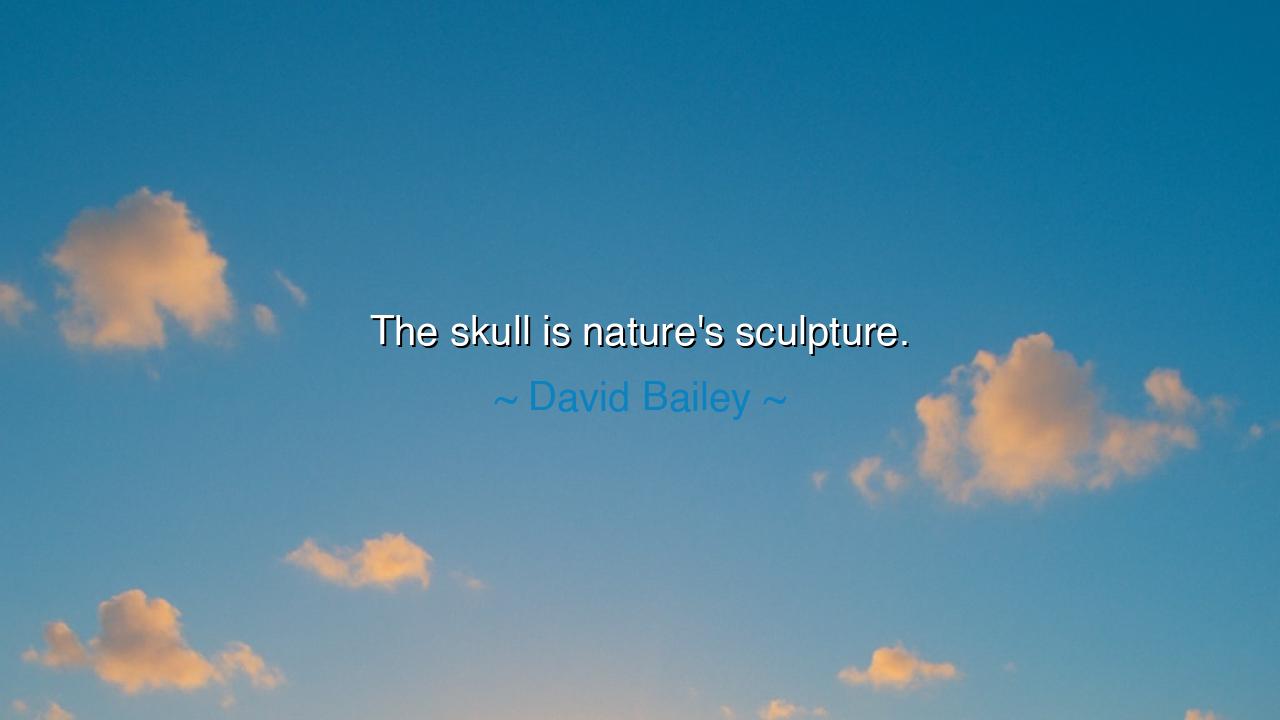
The skull is nature's sculpture.






In the words of David Bailey, the photographer who has spent a lifetime capturing the essence of human form, there is a phrase at once simple and profound: “The skull is nature’s sculpture.” This is no idle remark, but a meditation on the artistry hidden within the very structure of life. The skull, that silent architecture of bone, is at once terrifying and beautiful. It carries the memory of mortality, yet it is also the masterpiece of design, crafted not by human hands but by the slow, patient chisel of time, evolution, and nature itself.
To call the skull a sculpture is to see beyond its biology into its artistry. The lines, the curves, the sockets of the eyes, the vault that houses the mind—these are as deliberate and as perfect as any marble carved by Michelangelo. Where the sculptor of Florence once revealed David from stone, Nature herself has revealed in the skull the vessel of thought, the guardian of the brain, the throne of consciousness. It is not a thing of chance, but of artistry; not a crude shell, but a work of sublime design.
The skull also carries with it the eternal reminder of death. Across civilizations, from the Aztec temples to the catacombs of Rome, men have revered the skull as a symbol of life’s fleeting nature. It is the memento mori, whispering to kings and beggars alike that all flesh shall pass, but the form endures. In this sense, Bailey’s phrase speaks not only of artistry, but of wisdom: nature sculpts not merely for beauty, but for meaning, embedding into the skull a message of humility and remembrance.
History gives us many examples of this recognition. The monks of medieval Europe would keep skulls upon their desks as they wrote their manuscripts, reminding themselves that even knowledge and glory fade. The Day of the Dead in Mexico transforms the skull into a celebration, a sculpture of joy and color that honors ancestors while acknowledging mortality. In both East and West, across ages, the skull has been revered not only as bone but as symbol, carrying the power of art to move the spirit and awaken reflection.
Yet Bailey, as an artist of faces, saw something more. Every portrait he captured was built upon the unseen geometry of the skull beneath. The face, with all its expressions and moods, rests on the eternal architecture of bone. Beneath the smile, beneath the sorrow, beneath the flesh itself is the sculpture of nature, reminding us that all beauty springs from structure, all art rests upon foundation. Thus, in his words, we hear both reverence and recognition: the skull is not grotesque, but the hidden artistry behind every human visage.
The meaning of the quote, then, is twofold: it is at once a celebration of nature’s craftsmanship and a meditation on the fragility of life. The skull protects the mind, yet it also outlasts the body. It is both cradle and tomb, both beginning and end. It reveals to us the paradox of existence: that beauty and death are intertwined, that art and decay coexist, and that the truest masterpieces are those shaped by time itself.
The lesson we can take is this: honor the artistry of nature, for it is greater than any art made by man. Look with reverence upon the form of the body, the structure of life, the silent sculptures all around us—in shells, in stones, in bones. Let the skull remind you of humility, for it is the one mask we all share when flesh has fallen away. And let it remind you also to live fully, to create with urgency, knowing that though the body is temporary, the essence of art and meaning may endure.
Thus, David Bailey’s words echo like a chant of the ancients: “The skull is nature’s sculpture.” Let us take them not as cold observation, but as revelation. For within the hollow of the skull lies the throne of thought, the symbol of mortality, and the proof that nature herself is the greatest of sculptors, forever shaping us in beauty, mystery, and truth.






AAdministratorAdministrator
Welcome, honored guests. Please leave a comment, we will respond soon